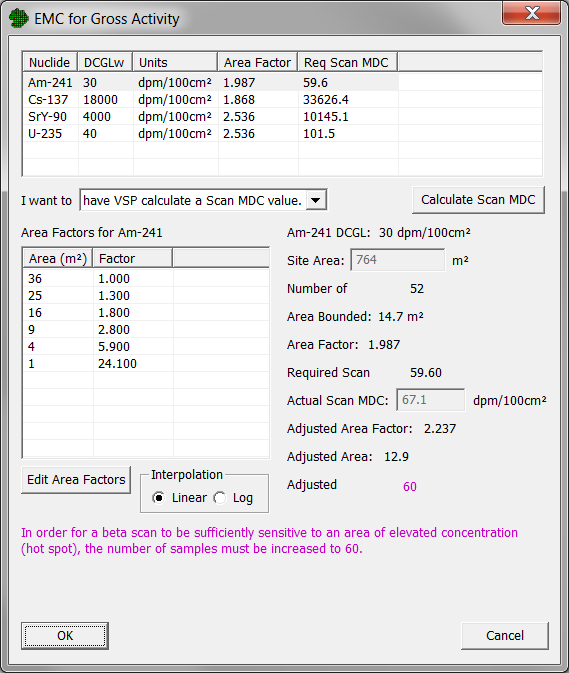
This dialog is used to determine whether the number of soil samples needs to be increased in order to be sufficiently sensitive to an area of elevated concentrations (hot spot).

The dialog has the following controls:
Nuclide Grid |
Where the intermediate calculations and the required scan minimum detection concentration (MDC) is displayed. |
Manual / Automatic selector |
Choose to enter the scan MDC directly or enter efficiencies and have VSP calculate the scan MDC. |
Calculate Scan MDC button |
Click this button to access the dialog where efficiencies can be entered and the scan MDC calculated. |
Site Area |
If the project site map contains defined sample areas, the site size is displayed here in square meters. If there are no sample areas defined on the project site map, the are of the site can be entered here. |
Actual Scan MDC |
If manual mode, enter the actual scan minimum detectable concentration for the activity. If in automatic calculation mode, the scan MDC will be displayed here. |
Edit Area Factors button |
Click this button to edit the values in the area factor (AF) table for the nuclide that is currently selected in the Nuclide Grid. |
Linear / Log Interpolation |
Use these radio buttons to select linear or logarithmic interpolation of the area factor (AF) table when looking up the area factor from the site size, or vice versa. |
VSP begins by dividing the site area by the number of samples to compute the Area Bounded by each sample and displays the result.
In order to complete the calculations, an area factor table (AF) must be entered for each nuclide. The AF table typically has values ranging from 36 down to 1 square meters, however it only necessary to have values that bound the actual area of the site. If the actual site area falls outside the bounds of the table, you can click the Edit Area Factors button to edit the table.
Once the area factors are in place, VSP next does a lookup interpolation of the Area Bounded in the AF table to yield an area factor for each nuclide. The interpolation can be done linearly or logarithmically, depending on the user selection. Logarithmic interpolation tends to yield lower area factors, producing more conservative results.
The area factor is multiplied by the DCGLw to produce a Required Scan DC for each nuclide. The overall lowest required scan MDC is displayed.
To continue, the user must enter an Actual Scan MDC for the activity (or use the optional automatic calculation). If the Actual Scan MDC is below the Required Scan MDC, no adjustments are necessary for the activity.
If the Actual Scan MDC is greater than the Required Scan MDC, VSP divides the Actual Scan MDC by the DCGLw of the nuclide with the lowest required scan MDC to produce a New Area Factor. A lookup interpolation is make in the reverse direction in the AF table to produce a new bounded area that is displayed in the Nuclide Grid. If the AF table does not bound the New Area Factor, the AF table must be edited and expanded to bound the factor.
The site area is divided by the new bounded area to produce the adjusted number of samples required for each nuclide. The number of samples is rounded up to the next whole number and displayed in the Nuclide Grid. A message is also displayed that explains the adjusted number of samples.
Clicking the OK button sends the results back to the design page, where the EMC Adjusted Samples will be displayed and used to drive the design.